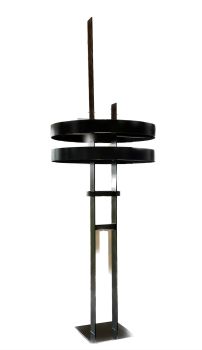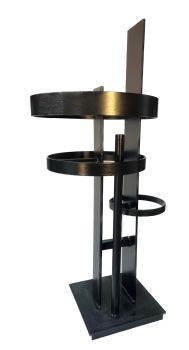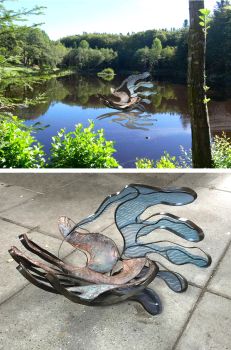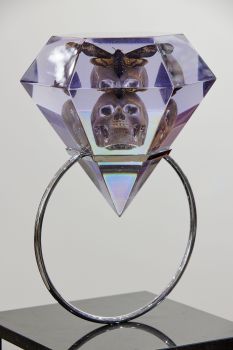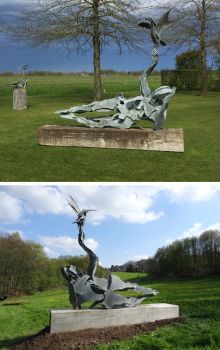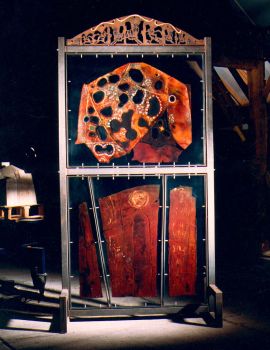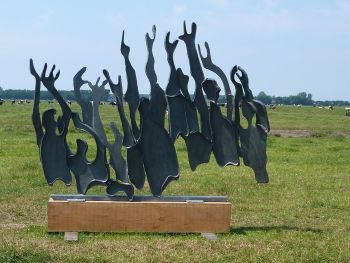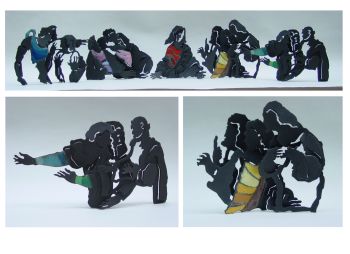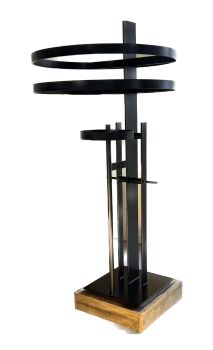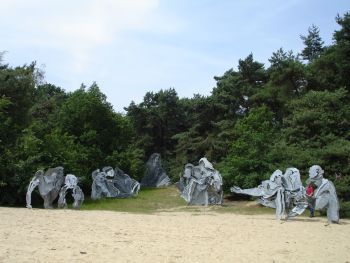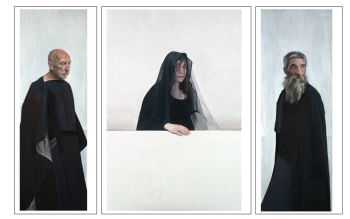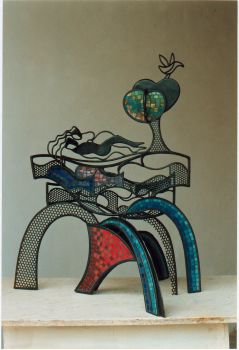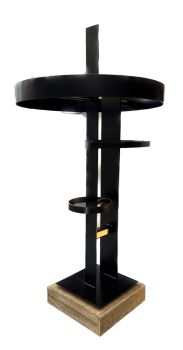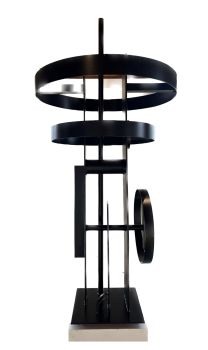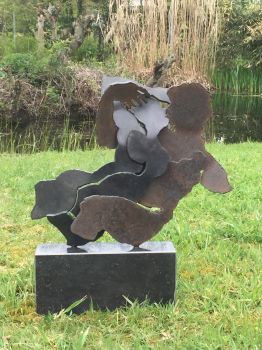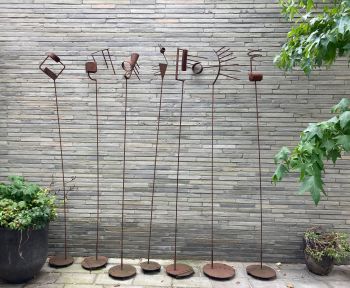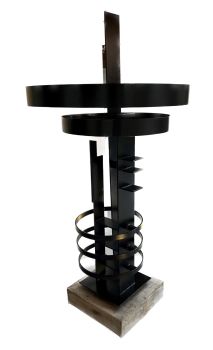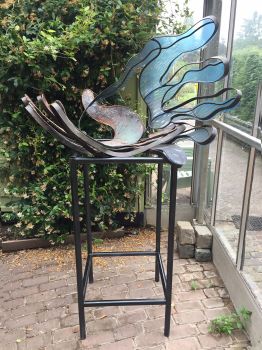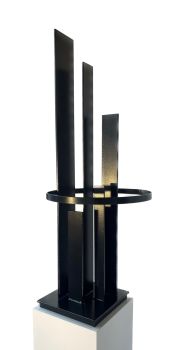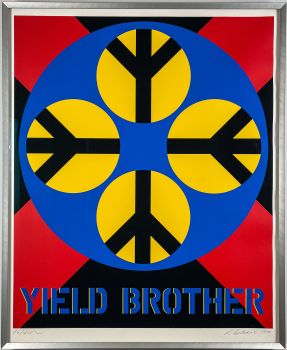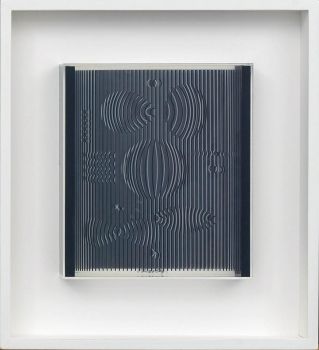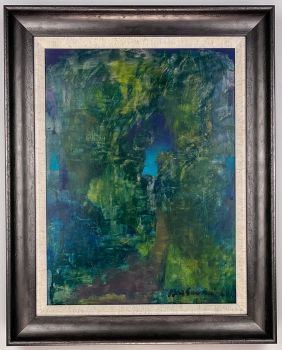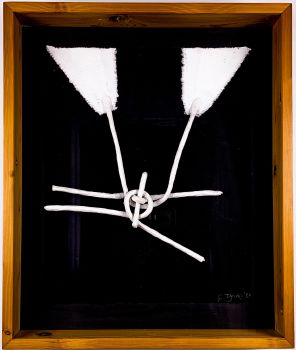Vintage "Divan II" pendant - Lyfa, Denmark circa 1970 1970 - 1979
Simon P. Henningsen
Chromed steelSteelMetalPaint
32 ⨯ 24 ⨯ 24 cm
ConditionVery good
€ 1.425
Van Kerkhoff Art
- About the artworkA chromed and lacquered steel pendant, model "Divan II". Designed in 1962 by Simon Henningsen and executed by Lyfa, Denmark circa 1970.
This light was designed for the "Divan II" restaurant that stood on a beautiful location in the Tivoli amusement park in Copenhagen between 1962 and 2011 when it unfortunately closed.
The lamp consists of 20 trapezium shaped metal shades that are chromed on the outside and lacquered on the inside. The colours used are red, purple, blue, aqua and cream (inside to outside). The shades are angled in such a way that you cannot be blinded by the bulbe and the same time the different colours are reflected by chromed side of the shades.
This pendant is a vintage example in a very good original condition. Our estimation is that it is probably produced circa 1970.
About Simon P. Henningsen
Simon Poul Henningsen (1920 Gentofte – 1974 Copenhagen) was a Danish architect and designer. Son of the famous Danish designer of lighting Poul Henningsen and his first wife Else Strøyberg, Simon Henningsen grew up in the heart of Danish cultural life.
Like his father Simon studied Architecture and like his father he did not finish his education. He worked together with his father on several designs for the Tivoli amusement park in Copenhagen, eventually following in his footsteps as the chief architect in 1948.
As he died at a young age, he was only 54 years old. He occupied himself with lighting designs only for about a decade. His first lamp Simon Henningsen designed in 1954 and was dubbed the SH lamp, in the 1950’s his lights had more organic forms compared the his designs from the 1960’s.
His two most well known designs were the Divan II, designed for the Divan restaurant in Tivoli and the Casablanca / Kassablanka lamp. Both of these designs were made by Lyfa and were complex and expensive to produce because of the materials and craftmanship used. - About the artist
Danish architect and lighting designer Simon P. Henningsen was born in Copenhagen in 1920, the son of legendary lighting designer Poul Henningsen (1894-1967) and his wife Else Stroyberg. Between witnessing his father’s ongoing lighting experiments and being surrounded by design luminaries from a young age, Henningsen emerged from his formative years with a wealth of design expertise.
During World War II, Simon began studying architecture, but like his father never graduated. Instead, he became heavily involved in hands-on work and experiments with his father. In the postwar reconstruction era, Henningsen became infatuated with the Tivoli Gardens in Copenhagen. In 1948, he became the public park’s head architect—which would become his life’s work and from where most of his lighting designs would emerge. Wanting to highlight the natural beauty, Simon developed a style that was artistic and organic, fully rejecting the use of harsh, fluorescent bulbs.
Simon’s first light was unveiled in 1954 and was aptly named the SH Lamp in homage to his father’s collection for Louis Poulsen. Whereas the PH series was based on the researched concept of utilizing multiple shades and diffusors, Simon admitted that his shade wasn’t as scientifically composed as his father’s. Instead, Simon’s designs had a more whimsical aesthetic, realized in whirls, geometric shapes, and flower-like forms, for example the Tivoli Havelampe (1958). This garden illumination—which was later put into production by Danish lighting manufacturer Lyfa—seamlessly blended in to the natural environment of the garden. In 1959, he designed a heating lamp to prolong the outdoor season in Tivoli, which was later put into production by Fog & Mørup.
Henningsen’s most well known work is the spectacular Divan 2 Pendant (1962), designed for the Divan 2 restaurant in Trivoli to hang over the dinner tables and to reflect the natural light of the nightly sunsets and flickering candles. A truly unique lamp, it’s made of sharply angled mirrored glass with a jazzy palette of reds and blues. Lyfa picked up the Divan 2 for its collection, and it became an immediate commercial success. In 1964, the award-winning Divan 2 was exhibited in the Louvre and installed in Georg Jensen’s 5th Avenue store in New York. Other successful lamps by Henningsen for Lyfa include the Kassablanka (ca. 1960s) and Nippon (1970) pendant lights.
Henningsen passed away in 1974 at the young age of 54.
Are you interested in buying this artwork?
Artwork details
Related artworks
- 1 - 1 / 1
Unknown artist
A rare Japanese export lacquer medical instrument box1650 - 1700
Price on requestZebregs & Röell - Fine Art - Antiques
Unknown artist
A COLLECTION OF FOUR SRI LANKAN IVORY BIBLE BOXES18th century
Price on requestZebregs & Röell - Fine Art - Antiques
1 - 4 / 24- 1 - 4 / 24
Victor Vasarely
"Venus", multiple 1987 - professionally framed, museumglass1987
€ 3.700Van Kerkhoff Art
 Curated by
Curated byDanny Bree
1 - 4 / 12



























